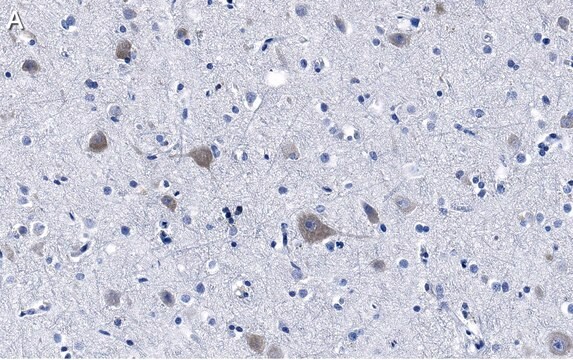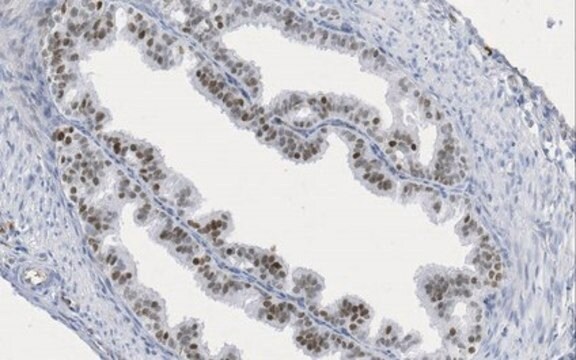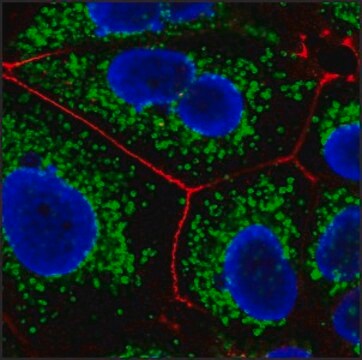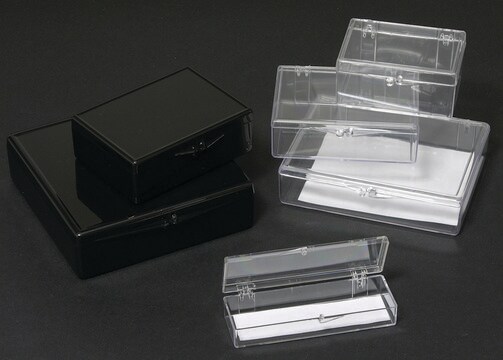Opis ogólny
Jesteśmy zaangażowani w dostarczanie bardziej ekologicznych produktów alternatywnych, które są zgodne z co najmniej jedną z 12 zasad zielonej chemii. To przeciwciało nie zawiera konserwantów, jest produkowane bez szkody dla zwierząt i wyjątkowo stabilne, aby umożliwić wysyłkę i przechowywanie w razie potrzeby, a tym samym jest zgodne z "Zapobieganiem powstawaniu odpadów", "Projektowaniem bezpieczniejszych chemikaliów" i "Projektowaniem pod kątem efektywności energetycznej".
Kliknij tutaj, aby uzyskać więcej informacji.
Przeciwciała 10889 stanowią całkowicie nową generację rekombinowanych przeciwciał monoklonalnych. Każde przeciwciało 10889 jest wytwarzane przy użyciu naszego zastrzeżonego systemu ekspresji rekombinowanej, oczyszczane do jednorodności i precyzyjnie dozowane w celu uzyskania solidnej i wysoce powtarzalnej konsystencji między partiami. Do użytku badaczy udostępniane są wyłącznie klony o najwyższej wydajności. Każde przeciwciało jest walidowane pod kątem wysokiej swoistości i powinowactwa w wielu zastosowaniach, w tym w najczęściej używanym zastosowaniu. Przeciwciała 10889 są niezawodnie dostępne i gotowe do wysyłki, gdy są potrzebne.
Specyficzność
Klon dG9 jest mysim rekombinowanym przeciwciałem monoklonalnym 10889, które specyficznie wykrywa Perforin-1.
Immunogen
Oczyszczone ziarnistości z linii ludzkich cytotoksycznych dużych ziarnistych limfocytów chłoniaka YT.
Zastosowanie
Testy kontroli jakości
Oceniane metodą Western Blotting z rekombinowaną ludzką perforyną-1 znakowaną His/SUMO.
Analiza Western Blotting: Rozcieńczenie 1:500 tego przeciwciała wykryło rekombinowaną ludzką Perforin-1 znakowaną His/SUMO.
Testowane aplikacje
Analiza cytometrii przepływowej: 1 µg z reprezentatywnej partii wykrył Perforin-1 w milionie ludzkich komórek jednojądrzastych krwi obwodowej (PBMC).
Analiza immunocytochemiczna: Rozcieńczenie 1:100 z reprezentatywnej partii wykryło Perforin-1 w komórkach SW480.
Uwaga: Rzeczywiste optymalne rozcieńczenia robocze muszą być określone przez użytkownika końcowego jako próbki, a warunki eksperymentalne mogą się różnić w zależności od użytkownika końcowego.
Opis wartości docelowych
Perforyna-1 (UniProt: P14222; znana również jako P1, cytolizyna, białko tworzące pory limfocytów, PFP) jest kodowana przez gen PRF1 (znany również jako PFP) (Gene ID: 5551) u człowieka. Perforyna-1 jest wieloprzebiegową glikoproteiną błonową, która jest syntetyzowana z peptydem sygnałowym (aa 1-25), który jest następnie odcinany w celu wytworzenia dojrzałej formy zawierającej dwie domeny transbłonowe (aa 129-149 i 257-279). Jest ona przechowywana w ziarnistościach cytolitycznych limfocytów T i wydzielana do szczeliny między limfocytem T a komórką docelową. Perforyna ma cienką strukturę w kształcie 3201 składającą się z N-końcowej domeny perforin-like membrane attack complex (MACPF)/ cholesterol dependent cytolysin (CDC) (aa 27-375), po której następuje domena EGF (aa 376-408), która wraz z sekwencją 9810 C-końcową tworzy centralną strukturę podobną do półki. Jego C-końcowa domena C2 (aa 397-519) pośredniczy w początkowym, zależnym od Ca2+ wiązaniu z błoną. Perforin-1 służy jako białko tworzące pory, które odgrywa rolę 3201 w programowanej śmierci komórki za pośrednictwem granzymu oraz w obronie przed komórkami zakażonymi wirusem lub nowotworowymi. Odgrywa również ważną rolę w zabijaniu innych komórek, które są rozpoznawane przez układ odpornościowy jako nieswoje. Może wnikać do błony komórek docelowych w postaci związanej z wapniem i może oligomeryzować i tworzyć duże pory. Jego wprowadzenie do błony i tworzenie porów wymaga poważnej zmiany konformacji. Promuje cytolizę i apoptozę komórek docelowych poprzez ułatwianie wychwytu cytotoksycznych granzymów. Mutacje w genie PRF1 zostały powiązane z rodzinną limfohistiocytozą hemofagocytarną (FHL2), rzadkim zaburzeniem charakteryzującym się dysregulacją immunologiczną z hipercytokinemią, wadliwą funkcją komórek naturalnych zabójców i masywną infiltracją kilku narządów przez aktywowane limfocyty i makrofagi. To rekombinowane przeciwciało monoklonalne 10889, generowane przez naszą zastrzeżoną technologię, oferuje znacznie zwiększoną swoistość, 4595, powtarzalność i stabilność w porównaniu z konwencjonalnymi przeciwciałami monoklonalnymi. (Ref.: Praper, T., et al. (2011). J. Biol. Chem. 286(4); 2946-2955; Law, RHP., et al. (2010). Nature. 468(7322). 447-451; Ando, K., et al. (1997). J. Immunol. 158(11); 5283-5291).
Postać fizyczna
Oczyszczone rekombinowane mysie przeciwciało monoklonalne IgG, liofilizowane w PBS, 5% trehalozy, o normalnym wyglądzie gruboziarnistej lub półprzezroczystej żywicy. Składniki PBS/trehaloza w preparacie ZooMAb po liofilizacji mogą mieć wygląd półstały (żel przypominający kulki). Jest to zjawisko normalne. Należy postępować zgodnie z zalecaną procedurą rekonstytucji zawartą w arkuszu danych, aby rozpuścić półstały, przypominający kulki materiał o wyglądzie żelu. Otrzymany roztwór przeciwciała jest całkowicie stabilny i funkcjonalny, co potwierdzają pełne testy funkcjonalne. Nie zawiera biocydów ani konserwantów, takich jak azydek, ani żadnych produktów ubocznych pochodzenia zwierzęcego. Większe opakowania są dostarczane jako wielokrotności 25 µL.
Przechowywanie i stabilność
Zaleca się przechowywanie liofilizowanego produktu w temperaturze 2-8°C. Przed rekonstytucją fiolki należy krótko mikrowirować, aby odwirować materiał na dno fiolki. Każdą fiolkę należy odtworzyć, dodając 25 µl przefiltrowanej wody laboratoryjnej lub PBS. Odtworzone przeciwciała można przechowywać w temperaturze 2-8°C lub -20°C w celu długotrwałego przechowywania. Unikać wielokrotnego zamrażania.
Informacje prawne
Affinity is a trademark of Mine Safety Appliances Co.
KEY is a registered trademark of Hanna Instruments
ZooMAb is a registered trademark of Merck KGaA, Darmstadt, Germany
eXTReme is a trademark of Excel Scientific, Inc.
Oświadczenie o zrzeczeniu się odpowiedzialności
O ile nie określono inaczej w naszym katalogu lub innej dokumentacji firmy dołączonej do produktu(-ów), nasze produkty są przeznaczone wyłącznie do użytku badawczego i nie mogą być wykorzystywane do żadnych innych celów, w tym między innymi do nieautoryzowanych zastosowań komercyjnych, zastosowań diagnostycznych in vitro, zastosowań terapeutycznych ex vivo lub in vivo lub jakiegokolwiek rodzaju konsumpcji lub zastosowania u ludzi lub zwierząt.
Ta strona może zawierać tekst przetłumaczony maszynowo.










